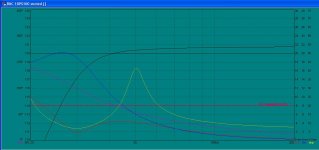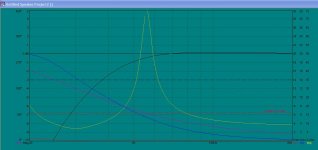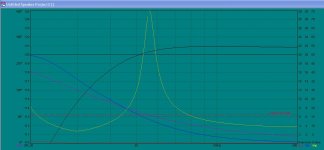You are right my simplification was a little odd although we might differ in some area's. I do agree that directivity in low frequency is always coupled to frequency and is never frequency consistent. I also agree that TH’s loose their directivity completely as frequency drops.The radiation pattern from a tapped horn is no different to any other box where the sound exits from the same area -- there's no "magic" which makes it any more or less directional, especially at bass frequencies, the atmosphere has got no way of knowing what's inside the box.
A big array of tapped horns will be directional (as Tom has demonstrated), especially if the flat faces of the boxes form a radiation boundary -- but so will a big array of reflex boxes the same size with the same frontal area.
However, you can see a rise in directivity from around 80Hz and upwards (from single units) that differs from a basreflex of similar front size. Since the size of the acoustic source + the total area from the front baffle is way to small to act as an (1/4WL) reflector it is not ‘reflection’ from the front baffle that increases its directivity. Instead the front baffle tends to act more like a system extender instead of a true reflector. This is also a reason why some measure a less steep drop as predicted.
I also don't agree you need big stacks of TH’s or basreflex to make them more directional. Every doubling increases the narrowing of the pattern since the sources start to couple acoustically. But if you just use two TH’s and compare them with two basreflex cabs (of similar front dimensions), you still will see a difference in the directivity between the two sets. The TH’s become more directional and the 80Hz directivity starting point start to drop already. The increase of acoustic coupled sources is limited by their 1/4WL. It can raise the total efficiency (in forward radiated direction) to up about 15% to 30%, depending on the design of the front baffles, after which no further increase in efficiency is possible. To prevent confusing, this counts for all systems.
Hi iand,
Post #19: "...Forget about passive crossovers..."
It may be of interest to mention, that in a tapped horn a series inductor can sometimes be of help to flatten the passband response (in Hornresp: add the resistive component to Rg and the inductance to Le). This also touches on one of the problems in software simulations, the inductance in the passband has to be known for the simulation to be accurate; e.g.: The Selenium 18SWS800 is one of the few drivers that provides more than the typical voice coil inductance @ 1kHz value (from the data sheet: Le @ FS 7.983 mH - Le @ 1kHz 3.872 mH - Le @ 20kHz 2.064 mH). epa came up with a rule of thumb to double the 1kHz value for use in Hornresp for subs.
Regards,
I know, this very often flattens out the response -- the problem with high-power systems is finding inductors with low enough resistance that don't saturate and distort at high currents, there are pretty much no cored inductors that can cope (if you can find real data, most manufacturers carefully don't give this) and even the biggest air-cored inductors (e.g. Erse XQ) will get too hot due to series resistance -- the lowest DCR 6mH inductor is still 0.46ohms which will lose more than 10% (too much) with a 4 ohm driver, and weighs nearly 6lbs...
ERSE-XQ
Although I wouldn't claim any "magic", tapped horns and FLH do have quite a bit more directivity in the upper bass range than a bass reflex cabinet.The radiation pattern from a tapped horn is no different to any other box where the sound exits from the same area -- there's no "magic" which makes it any more or less directional, especially at bass frequencies, the atmosphere has got no way of knowing what's inside the box.
A big array of tapped horns will be directional (as Tom has demonstrated), especially if the flat faces of the boxes form a radiation boundary -- but so will a big array of reflex boxes the same size with the same frontal area.
The radiation pattern from a tapped horn is different than a bass reflex cabinet.
Actual measurements in this post:
http://www.diyaudio.com/forums/subwoofers/184982-tapped-horn-directivity.html
The BR cabinet was basically omnidirectional within about 1 dB to 60 Hz, then looses about 3 dB off axis at 125, and around 7 dB at 160 Hz.
The FLH C-horn is basically omnidirectional within about 3 dB to 60 Hz, then looses about 7 dB at 125 Hz, and above. The C-horn has a smaller frontal area than the BR cabinet, the horn is obviously affecting dispersion, not just panel size.
The Keystone TH is basically omnidirectional within about 2 dB to 60 Hz, then looses about 12 dB at 125, and around 9 dB at 160 Hz.
The radiation from the front and back of the cone are imparting a different dispersion at upper frequencies, a different effect than the BR and FLH, which both seem to just narrow more at upper frequencies.
Art Welter
Last edited:
Although I wouldn't claim any "magic", tapped horns and FLH do have quite a bit more directivity in the upper bass range than a bass reflex cabinet.
The radiation pattern from a tapped horn is different than a bass reflex cabinet.
Actual measurements in this post:
http://www.diyaudio.com/forums/subwoofers/184982-tapped-horn-directivity.html
The BR cabinet was basically omnidirectional within about 1 dB to 60 Hz, then looses about 3 dB off axis at 125, and around 7 dB at 160 Hz.
The FLH C-horn is basically omnidirectional within about 3 dB to 60 Hz, then looses about 7 dB at 125 Hz, and above. The C-horn has a smaller frontal area than the BR cabinet, the horn is obviously affecting dispersion, not just panel size.
The Keystone TH is basically omnidirectional within about 2 dB to 60 Hz, then looses about 12 dB at 125, and around 9 dB at 160 Hz.
The radiation from the front and back of the cone are imparting a different dispersion at upper frequencies, a different effect than the BR and FLH, which both seem to just narrow more at upper frequencies.
Art Welter
OK, but are we really supposed to use a "subwoofer" above about 100Hz (or even 80)? I would think it would become a "woofer" above about 100Hz.
The Subwoofer DIY Page - Subwoofer Integration
Who mentioned "subwoofer"OK, but are we really supposed to use a "subwoofer" above about 100Hz (or even 80)? I would think it would become a "woofer" above about 100Hz.
Many systems use top speakers that don't make it much below 200 Hz, there are some TH that do OK that high, though they usually don't go below 50 Hz.
Even with a 24 dB per octave crossover at 100 Hz, the output of the woofer generally will be audible past 125 Hz, many DIY use passive crossovers and the output may be audible to past 200 Hz with a 80-100 Hz 1st order crossover.
For those crossing subs at 24 dB per octave at 80 Hz or lower, directivity difference between sub designs won't be very noticeable.
When crossing upwards of 200 Hz, there can be a quite a difference, the top speaker may be almost omni down that low, couple that to a narrow dispersion bass speaker and things get interesting
Art Welter
Series Inductor
Hi iand,
Post #22
I agree that for low impedance drivers, and, for PA applications series inductors might not be the way to go, but for home applications they can come in handy, e.g.: Erse 16 Gauge Super Q Inductors at Parts Express .
Regards,
Hi iand,
Post #22
I agree that for low impedance drivers, and, for PA applications series inductors might not be the way to go, but for home applications they can come in handy, e.g.: Erse 16 Gauge Super Q Inductors at Parts Express .
Regards,
Hi iand,
Post #22
I agree that for low impedance drivers, and, for PA applications series inductors might not be the way to go, but for home applications they can come in handy, e.g.: Erse 16 Gauge Super Q Inductors at Parts Express .
Regards,
Agreed -- but the Selenium 18SWS800 would be suited for PA, not home cinema ;-)
Agreed -- but the Selenium 18SWS800 would be suited for PA, not home cinema ;-)
Why? I'm going to use the B&C 18PS100 in a vented box of 7.5 cu ft. I have a 300 watt BASH amp from O Audio already.
Why? I'm going to use the B&C 18PS100 in a vented box of 7.5 cu ft. I have a 300 watt BASH amp from O Audio already.
OK, I'll rephrase -- if you're going to drive it at full power without running out of Xmax you'll get ludicrous SPL but only down to about 40Hz (even in a big box), which makes it more suitable for PA than home cinema ;-)
Of course you can drive it with less power and tune the box lower, but this is a waste of driver efficiency (at higher frequencies) for home cinema, you could get better results in a smaller box with a driver with lower efficiency and more Xmax which is optimised for home cinema.
None of the high-efficiency PA drivers (except freaks like the TC PRO-5100) have got enough Xmax to sustain maximum output below 30Hz, and if you want to get to 20Hz or below even this doesn't have enough Xmax, you need something like the drivers from Ascendant Audio or FiCar or AE or CSS or SoundSplinter or...
OK, I'll rephrase -- if you're going to drive it at full power without running out of Xmax you'll get ludicrous SPL but only down to about 40Hz (even in a big box), which makes it more suitable for PA than home cinema ;-)
Of course you can drive it with less power and tune the box lower, but this is a waste of driver efficiency (at higher frequencies) for home cinema, you could get better results in a smaller box with a driver with lower efficiency and more Xmax which is optimised for home cinema.
None of the high-efficiency PA drivers (except freaks like the TC PRO-5100) have got enough Xmax to sustain maximum output below 30Hz, and if you want to get to 20Hz or below even this doesn't have enough Xmax, you need something like the drivers from Ascendant Audio or FiCar or AE or CSS or SoundSplinter or...
The Selenium is pretty good. See attached graph. The -3dB point is 38Hz and the driver is hardly working at all far below that. It's in a 5.58 cu ft box tuned to 30Hz. With 300 watts input, it puts out about 120dB down to 50Hz and it's still hardly moving at all below that. It may not put out much below 30Hz, but most music is above that. I'm sure you'd still feel something with cinema sub bass also.
The B&C is in a 7.5 cu ft box and has a -3dB point of 32Hz.
Attachments
The Selenium is pretty good. See attached graph. The -3dB point is 38Hz and the driver is hardly working at all far below that. It's in a 5.58 cu ft box tuned to 30Hz. With 300 watts input, it puts out about 120dB down to 50Hz and it's still hardly moving at all below that. It may not put out much below 30Hz, but most music is above that. I'm sure you'd still feel something with cinema sub bass also.
The B&C is in a 7.5 cu ft box and has a -3dB point of 32Hz.
Something wrong with the excursion for the Selenium, surely? (The B&C looks OK)
Most home cinema buffs (nuts?) would say that a speaker which is -3dB at 38Hz isn't a sub at all...
(but they want dinosaur footsteps to make ceiling tiles fall off
Something wrong with the excursion for the Selenium, surely? (The B&C looks OK)
Most home cinema buffs (nuts?) would say that a speaker which is -3dB at 38Hz isn't a sub at all...
(but they want dinosaur footsteps to make ceiling tiles fall off
I double checked the Selenium parameters and they are correct.
I agree that 38Hz may not be deep enough for some folks, but placing a sub made with the Selenium driver in a corner should extend the LF response somewhat. Also, because the Selenium is hardly breathing even at 300 watts input, then distortion should be very low as well. In that respect it's better than the B&C I picked.
Also, we have to beware of "fake bass" from distortion products:
Nonlinear distortion testing of loudspeaker driver units
I believe that using a driver that has the lowest excursion at the SPL and -3dB point you desire is best for good sound quality. This is the advantage of bass horns of course, provided you have the space in the back yard to bury the driver....
Maybe a Bass Shaker is a better choice for cinema bass? Hmmm....
Last edited:
I double checked the Selenium parameters and they are correct.
I agree that 38Hz may not be deep enough for some folks, but placing a sub made with the Selenium driver in a corner should extend the LF response somewhat. Also, because the Selenium is hardly breathing even at 300 watts input, then distortion should be very low as well. In that respect it's better than the B&C I picked.
Also, we have to beware of "fake bass" from distortion products:
Nonlinear distortion testing of loudspeaker driver units
I believe that using a driver that has the lowest excursion at the SPL and -3dB point you desire is best for good sound quality. This is the advantage of bass horns of course, provided you have the space in the back yard to bury the driver....
Maybe a Bass Shaker is a better choice for cinema bass? Hmmm....
The B&C plot has about 4mm Xmax above resonance at 120dB which makes sense, the Selenium has something like 0.3mm (too small to see) which doesn't...
Usually it's the fraction of Xmax which is used that determines distortion (if a driver is properly designed), in other words how much of Vd is being used up. An 18" driver with 8mm Xmax, a 15" one with 11mm and a 12" one with 16mm can all shift the same amount of air (Sd*Xmax) and will have the same maximum SPL at low frequencies with the same distortion (in theory); the 18" will have more output at higher frequencies (if this is useful) and need a bigger box.
Of course there are other tradeoffs too, the smaller drivers need more linear suspension but will have lower distortion due to cone flexure. I you're happy with a big box which goes down to the high 30's then the Selenium is fine, but it's not what most people would choose for home cinema.
The B&C plot has about 4mm Xmax above resonance at 120dB which makes sense, the Selenium has something like 0.3mm (too small to see) which doesn't...
Usually it's the fraction of Xmax which is used that determines distortion (if a driver is properly designed), in other words how much of Vd is being used up. An 18" driver with 8mm Xmax, a 15" one with 11mm and a 12" one with 16mm can all shift the same amount of air (Sd*Xmax) and will have the same maximum SPL at low frequencies with the same distortion (in theory); the 18" will have more output at higher frequencies (if this is useful) and need a bigger box.
Of course there are other tradeoffs too, the smaller drivers need more linear suspension but will have lower distortion due to cone flexure. I you're happy with a big box which goes down to the high 30's then the Selenium is fine, but it's not what most people would choose for home cinema.
I went with the 18" driver because I couldn't find a 15" one I liked.
I'm not really designing a sub for home cinema anyway, but music instead. I now think that Bass Shakers installed in the sofa are a better idea for cinema bass.
- Status
- This old topic is closed. If you want to reopen this topic, contact a moderator using the "Report Post" button.
- Home
- Loudspeakers
- Subwoofers
- why is a tapped horn more efficient than ported?


